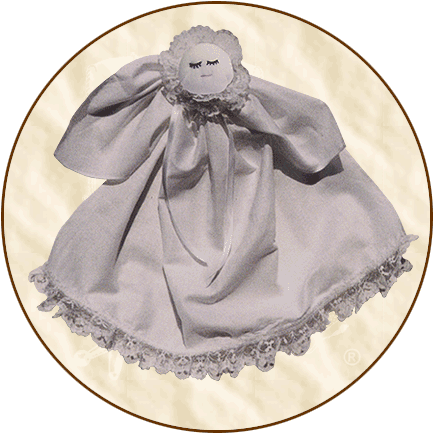.
Continued from product description on
Historical Doll Kits' Page Two...
Historical
Background: During the Civil War (and at other times when
supplies were scarce), dolls were made from handkerchiefs for
little girls. These "handkerchief dolls" were carried
to church and did not make noise if they were dropped. They were
also known as one of the "Sunday toys" that children
were allowed to play with only on Sundays, along with Noah's
Ark, Jacob's Ladder (2005), Buzz Saw (2001), and other quiet
toys. Some mothers would put sugar cubes or candy in the head
of the handkerchief doll for a youngster to suck on to keep the
child quiet during the long church service. Other names for the
handkerchief doll are: "church doll," "church
babies," "pew doll," "pew babies," and
"prayer doll."
The pocket handkerchief is about 400 years old, but the history
of the handkerchief begins as far back as Classical Greece and
the Roman Empire. The handkerchief was first mentioned in literature
by the poet Catullus (87-57 B.C.). It was also written about
in great detail by William Shakespeare in "Othello."
The handkerchief given to Desdemona by Othello passes into many
other hands before the end of the play.
Handkerchiefs were not only used as face cloths for absorbing
perspiration, they were used to hide one's face and to cover
the mouth during adverse weather conditions or prevent inhaling
infectious germs. The handkerchief was also an important favor
for a man to give to a lady, and vice versa.
During Classical Greek times, a perfumed cloth was used by
the wealthy. These were known as "mouth cloths," or
"perspiration cloths." In Rome during the first century,
men of rank used an oblong linen cloth to wipe perspiration from
their hands and face. Throughout the Roman Empire, women carried
a silk or cotton square handkerchief. Roman games were signaled
to begin when a handkerchief was dropped. A handkerchief was
waved by spectators at these games to show their sign of approval.
A handkerchief used during the Middle Ages was a sign of being
wealthy and was clearly displayed as such. A knight would wear
a lady's handkerchief to publicly show he had her favor. In the
early Christian Church, the officiating priest carried a handkerchief
in his left hand. This evolved into a folded band, which became
known as the "maniple" by the 12th century. During
the Renaissance, the handkerchief (now called a "napkyn")
was made from silk, cambric, and lawn. These napkyns were usually
embroidered and/or featured exquisite lace. These handkerchiefs
were used by both men and women.
A Venetian lady cut a square from pure flax, decorated it
with lace, and showed it while in public. Those who saw it were
curious indeed. From Italy, this idea spread to France and became
a favorite with the lords and ladies in the court of King Henry
II. This handkerchief was no plain square of fabric! It was made
from the most expensive fabrics (such as silk or linen) and was
often embroidered. In 1850, German royalty adopted the idea of
the luxurious handkerchief. The handkerchief we think of is square,
but some handkerchiefs were made round or triangular.
The handkerchief became an important piece of a gentleman's
attire and was worn in the left breast pocket and folded in a
particular way. A white handkerchief was always proper with a
dark suit and multicolored tie, but a silk colored handkerchief
was appealing for a more invigorating look.
The handkerchief saw dramatic change in Europe during the
16th century. It was richly decorated, adorned with various laces
or fringed edges, and was meant to be displayed as a fashion
item rather than as something useful. Because it was such a beautiful
item, it was not used in the 17th century by elegant ladies who
took snuff. These ladies could only use a colored cloth, which
would hide the brownish stains caused by the tobacco. During
the 18th century, the handkerchief was considered a necessity
to have at the tragedies in the French theater. In the 19th century,
ladies carried handkerchiefs in their hands instead of hiding
them away in bags or purses. They were so common that everyone
carried a "hankie" everywhere they went. During the
Victorian era, this made it possible for a young woman to make
signals across a room to a young man with her handkerchief in
much the same way romantic signals were done with the fan. Handkerchiefs
were considered the perfect gift for anyone, young or old, male
or female, good friend or mere acquaintance.
After Kleenex facial tissues became popular in the 1930s and
1940s, the cloth handkerchief was less used. Handkerchiefs are
still fairly popular and sold in many stores. Also, a lot of
handkerchief dolls are still being made, not only for little
girls in church but as collectors' dolls and as decorations.
Today, small handkerchief dolls are hung on Christmas trees to
add a touch of Victorian tradition. After all, it was Queen Victoria's
husband, Prince Albert, who introduced England to the German
tradition of putting up and decorating Yuletide trees.
Fun
Fact: Marie Antoinette decided that the square form of
the handkerchief was more aesthetically pleasing, and King Louis
XIV published a decree ordering the length of the handkerchief
to be equal to its width.













